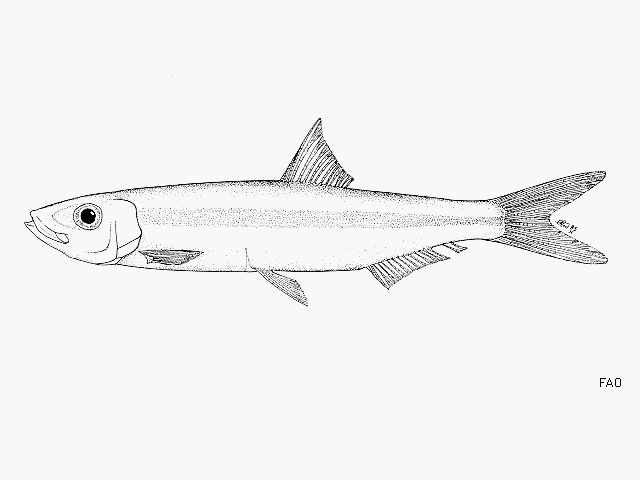|
Dorsal spines (total): 0-0; Dorsal soft rays (total): 14-17; Anal spines: 0-0; Anal soft rays: 16-18; Vertebrae: 45-46. Diagnosis: Body elongate, a little compressed; belly rounded, without pre-pelvic and post-pelvic scutes, but a pelvic scute present with slender vertical arms; gillrakers 26-31; pelvic fin with 1 unbranched and 7-8 branched finrays, well before dorsal fin origin; last two anal finrays separate, forming a distinct little finlet (Ref. 188, 117486, 121271). This species is distinguished from other clupeids by the presence of 2 anal fins, of which the second anal fin comprises 2 finrays (Ref. 188, 121271).
Description: Body elongate, a little compressed, belly rounded (Ref. 188, 117486). Body depth 15-22% of standard length; head length 25.2-27.7% of standard length (Ref. 117486, 118219, 121271). Pre-dorsal distance 51-58% of standard length; pre-anal distance 68-75% of standard length; pre-pelvic distance 47-55% of standard length (Ref. 117486, 118219, 121271). Snout pointed, a little shorter than eye diameter; jaws subequal, lower projecting slightly; maxilla longer than snout, reaching vertical through anterior border of the eye; a single supra-maxilla, expanded posteriorly, almost equal in length to maxilla in depth, with a narrow anterior shaft; a single row of conical teeth on pre-maxilla and maxilla (Ref. 117486, 118219). Gillrakers 26-31 on lower part of first gill arch (Ref. 188, 117486, 121280). Dorsal fin with 14-17 rays, dorsal fin origin a little nearer caudal fin base than tip of snout; a double anal fin, first part with 14-16 rays and second part with 2 rays, the last two rays of anal fin separated from others by a gap equal to three rays, anal fin origin nearer to pelvic fin base than to caudal fin base; pectoral fin with 1 unbranched and 11-12 branched rays; pelvic fin with 1 unbranched and 7-8 branched rays; pelvic fin origin in front of dorsal fin origin, nearer to anal fin base than to pectoral fin base (Ref. 94656, 117486, 118219, 121271). Scales: 41-45 scales in a longitudinal series; 8-9 transversal scales (Ref. 117486, 118219, 121271). Abdominal scutes entirely absent, but a pelvic scute with slender lateral arms present (Ref. 188, 117486). Branchiostegal rays 6 (Ref. 121271). Vertebrae 45-46; with 16-17 caudal vertebrae (Ref. 118219, 121271).
Colouration: Fresh specimens mainly translucent; dorsal and lateral surfaces very light brown, peritoneum white; a faint, poorly defined, silvery to golden lateral band from operculum to caudal base, widest behind dorsal base, narrower than pupil of eye; a few brown spots on head between orbits, post-orbital surface of head brown; two parallel rows of minute black spots on median dorsal surface from the nape to the dorsal origin and continued from the last dorsal ray to the caudal base; snout and tip of lower jaw faintly yellowish with a few small dark spots; lower jaw, sides of head and operculum silvery; bases of dorsal and caudal fin yellowish, caudal rays with minute orange spots and a few scattered melanophores; two black lines on caudal base and a black streak on the upper border of the caudal peduncle; a row of black spots along base of anal and first two rays of pectoral fin with a few melanophores, rest of fins colourless (Ref. 117486). Preserved specimens with dorsal side brown; a faint, poorly defined, silvery midlateral stripe on the flanks from operculum to caudal base; ventral side whitish; with a sigmoid spot at the base of the caudal fin (Ref. 117486, 118219, 121271). |

